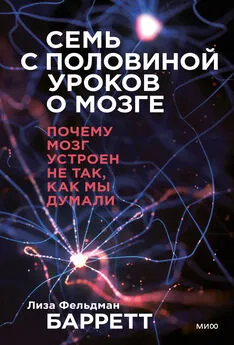Лиза Барретт - Как рождаются эмоции
- Название:Как рождаются эмоции
- Автор:
- Жанр:
- Издательство:Манн, Иванов и Фербер
- Год:2018
- Город:Москва
- ISBN:нет данных
- Рейтинг:
- Избранное:Добавить в избранное
-
Отзывы:
-
Ваша оценка:
Лиза Барретт - Как рождаются эмоции краткое содержание
Эта книга совершает революцию в понимании эмоций, разума и мозга. Вас ждет захватывающее путешествие по удивительным маршрутам, с помощью которых мозг создает вашу эмоциональную жизнь. Вы научитесь по-новому смотреть на эмоции, свои взаимоотношения с людьми и в конечном счете на самих себя. На русском языке публикуется впервые.
Как рождаются эмоции - читать онлайн бесплатно ознакомительный отрывок
Интервал:
Закладка:
Killingsworth, M. A., and D. T. Gilbert. 2010. “A Wandering Mind Is an Unhappy Mind.” Science 330 (6006): 932.
Kim, Min Y., Brett Q. Ford, Iris Mauss, and Maya Tamir. 2015. “Knowing When to Seek Anger: Psychological Health and Context-Sensitive Emotional Preferences.” Cognition and Emotion 29 (6): 1126–1136.
Kim, ShinWoo, and Gregory L. Murphy. 2011. “Ideals and Category Typicality.” Journal of Experimental Psychology: Learning, Memory, and Cognition 37 (5): 1092–1112.
Kimhy, David, Julia Vakhrusheva, Samira Khan, Rachel W. Chang, Marie C. Hansen, Jacob S. Ballon, Dolores Malaspina, and James J. Gross. 2014. “Emotional Granularity and Social Functioning in Individuals with Schizophrenia: An Experience Sampling Study.” Journal of Psychiatric Research 53: 141–148.
Kircanski, K., M. D. Lieberman, and M. G. Craske. 2012. “Feelings into Words: Contributions of Language to Exposure Therapy.” Psychological Science 23 (10): 1086–1091.
Kirsch, Irving. 2010. The Emperor’s New Drugs: Exploding the Antidepressant Myth . New York: Basic Books.
Kitzbichler, Manfred G., Richard N. A. Henson, Marie L. Smith, Pradeep J. Nathan, and Edward T. Bullmore. 2011. “Cognitive Effort Drives Workspace Configuration of Human Brain Functional Networks.” Journal of Neuroscience 31 (22): 8259–8270.
Klatzky, Roberta L., James W. Pellegrino, Brian P. McCloskey, and Sally Doherty. 1989. “Can You Squeeze a Tomato? The Role of Motor Representations in Semantic Sensibility Judgments.” Journal of Memory and Language 28 (1): 56–77.
Kleckner, I. R., J. Zhang, A. Touroutoglou, L. Chanes, C. Xia, W. K. Simmons, B. C. Dickerson, and L. F. Barrett. Under review. “Evidence for a Large-Scale Brain System Supporting Interoception in Humans.”
Klüver, Heinrich, and Paul C. Bucy. 1939. “Preliminary Analysis of Functions of the Temporal Lobes in Monkeys.” Archives of Neurology and Psychiatry 42: 979–1000.
Kober, H., L. F. Barrett, J. Joseph, E. Bliss-Moreau, K. Lindquist, and T. D. Wager. 2008. “Functional Grouping and Cortical-Subcortical Interactions in Emotion: A Meta-Analysis of Neuroimaging Studies.” Neuroimage 42 (2): 998–1031.
Koch, Kristin, Judith McLean, Ronen Segev, Michael A. Freed, Michael J. Berry, Vijay Balasubramanian, and Peter Sterling. 2006. “How Much the Eye Tells the Brain.” Current Biology 16 (14): 1428–1434.
Kohut, Andrew. 2015. “Despite Lower Crime Rates, Support for Gun Rights Increases.” Pew Research Center , April 17. http://www.pewresearch.org/fact-tank/2015/04/17/despite-lower-crime-rates-support-for-gun-rights-increases.
Kolodny, Andrew, David T. Courtwright, Catherine S. Hwang, Peter Kreiner, John L. Eadie, Thomas W. Clark, and G. Caleb Alexander. 2015. “The Prescription Opioid and Heroin Crisis: A Public Health Approach to an Epidemic of Addiction.” Annual Review of Public Health 36: 559–574.
Koopman, Frieda A., Susanne P. Stoof, Rainer H. Straub, Marjolein A. van Maanen, Margriet J. Vervoordeldonk, and Paul P. Tak. 2011. “Restoring the Balance of the Autonomic Nervous System as an Innovative Approach to the Treatment of Rheumatoid Arthritis.” Molecular Medicine 17 (9): 937–948.
Kopchia, Karen L., Harvey J. Altman, and Randall L. Commissaris. 1992. “Effects of Lesions of the Central Nucleus of the Amygdala on Anxiety-Like Behaviors in the Rat.” Pharmacology Biochemistry and Behavior 43 (2): 453–461.
Kostović, I., and M. Judaš. 2015. “Embryonic and Fetal Development of the Human Cerebral Cortex.” In Brain Mapping, An Encyclopedic Reference, Volume 2: Anatomy and Physiology, Systems , edited by Arthur W. Toga, 167–175. San Diego: Academic Press.
Kragel, Philip A., and Kevin S. LaBar. 2013. “Multivariate Pattern Classification Reveals Autonomic and Experiential Representations of Discrete Emotions.” Emotion 13 (4): 681–690.
Kreibig, S. D. 2010. “Autonomic Nervous System Activity in Emotion: A Review.” Biological Psychology 84 (3): 394–421.
Kring, A. M., and A. H. Gordon. 1998. “Sex Differences in Emotion: Expression, Experience, and Physiology.” Journal of Personality and Social Psychology 74 (3): 686–703.
Krugman, Paul. 2014. “The Dismal Science: ‘Seven Bad Ideas’ by Jeff Madrick.” New York Times, September 25. http://www.nytimes.com/2014/09/28/books/review/seven-bad-ideas-by-jeff-madrick.html.
Kuhl, Patricia K. 2007. “Is Speech Learning ‘Gated’ by the Social Brain?” Developmental Science 10 (1): 110–120.
——— . 2014. “Early Language Learning and the Social Brain.” Cold Spring Harbor Symposia on Quantitative Biology 79: 211–220.
Kuhl, Patricia, and Maritza Rivera-Gaxiola. 2008. “Neural Substrates of Language Acquisition.” Annual Review of Neuroscience 31: 511–534.
Kuhn, Thomas S. 1966. The Structure of Scientific Revolutions . Chicago: University of Chicago Press.
Kundera, Milan. 1994. The Book of Laughter and Forgetting . New York: HarperCollins.
Kupfer, Alexander, Hendrik Müller, Marta M. Antoniazzi, Carlos Jared, Hartmut Greven, Ronald A. Nussbaum, and Mark Wilkinson. 2006. “Parental Investment by Skin Feeding in a Caecilian Amphibian.” Nature 440 (7086): 926–929.
Kuppens, P., F. Tuerlinckx, J. A. Russell, and L. F. Barrett. 2013. “The Relationship Between Valence and Arousal in Subjective Experience.” Psychological Bulletin 139: 917–940.
Kuppens, Peter, Iven Van Mechelen, Dirk J. M. Smits, Paul De Boeck, and Eva Ceulemans. 2007. “Individual Differences in Patterns of Appraisal and Anger Experience.” Cognition and Emotion 21 (4): 689–713.
LaBar, Kevin S., J. Christopher Gatenby, John C. Gore, Joseph E. LeDoux, and Elizabeth A. Phelps. 1998. “Human Amygdala Activation During Conditioned Fear Acquisition and Extinction: A Mixed-Trial fMRI Study.” Neuron 20 (5): 937–945.
Lakoff, George. 1990. Women, Fire, and Dangerous Things: What Categories Reveal About the Mind . Chicago: University of Chicago Press.
Laland, Kevin N., and Gillian R. Brown. 2011. Sense and Nonsense: Evolutionary Perspectives on Human Behaviour . Oxford: Oxford University Press.
Lane, Richard D., Geoffrey L. Ahern, Gary E. Schwartz, and Alfred W. Kaszniak. 1997. “Is Alexithymia the Emotional Equivalent of Blindsight?” Biological Psychiatry 42 (9): 834–844.
Lane, Richard D., and David A. S. Garfield. 2005. “Becoming Aware of Feelings: Integration of Cognitive-Developmental, Neuroscientific, and Psychoanalytic Perspectives.” Neuropsychoanalysis 7 (1): 5–30.
Lane, Richard D., Lee Sechrest, Robert Riedel, Daniel E. Shapiro, and Alfred W. Kaszniak. 2000. “Pervasive Emotion Recognition Deficit Common to Alexithymia and the Repressive Coping Style.” Psychosomatic Medicine 62 (4): 492–501.
Lang, Peter J., Mark K. Greenwald, Margaret M. Bradley, and Alfons O. Hamm. 1993. “Looking at Pictures: Affective, Facial, Visceral, and Behavioral Reactions.” Psychophysiology 30 (3): 261–273.
Laukka, Petri, Hillary Anger Elfenbein, Nela Söder, Henrik Nordström, Jean Althoff, Wanda Chui, Frederick K. Iraki, Thomas Rockstuhl, and Nutankumar S. Thingujam. 2013. “Cross-Cultural Decoding of Positive and Negative Non-Linguistic Emotion Vocalizations.” Frontiers in Psychology 4 (353): 185–192.
Lawrence, T. E. (1922) 2015. Seven Pillars of Wisdom . Toronto: Aegitas.
Lazarus, R. S. 1998. “From Psychological Stress to the Emotions: A History of Changing Outlooks.” In Personality: Critical Concepts in Psychology , vol. 4, edited by Cary L. Cooper and Lawrence A. Pervin, 179–200. London: Routledge.
Lea, Stephen E. G. 2010. “Concept Learning in Nonprimate Mammals: In Search of Evidence.” In The Making of Human Concepts , edited by Denis Mareschal, Paul Quinn, and Stephen E. G. Lea, 173–199. New York: Oxford University Press.
Lebois, Lauren A. M., Christine D. Wilson-Mendenhall, and Lawrence W. Barsalou. 2015. “Are Automatic Conceptual Cores the Gold Standard of Semantic Processing? The Context-Dependence of Spatial Meaning in Grounded Congruency Effects.” Cognitive Science 39 (8): 1764–1801.
Lebrecht, S., M. Bar., L. F. Barrett, and M. J. Tarr. 2012. “Micro-Valences: Perceiving Affective Valence in Everyday Objects.” Frontiers in Perception Science 3 (107): 1–5.
Lecours, S., G. Robert, and F. Desruisseaux. 2009. “Alexithymia and Verbal Elaboration of Affect in Adults Suffering from a Respiratory Disorder.” European Review of Applied Psychology–Revue européenne de psychologie appliquée 59 (3): 187–195.
LeDoux, Joseph E. 2014. “Coming to Terms with Fear.” Proceedings of the National Academy of Sciences 111 (8): 2871–2878.
——— . 2015. Anxious: Using the Brain to Understand and Treat Fear and Anxiety . New York: Penguin.
Lee, Marion, Sanford Silverman, Hans Hansen, and Vikram Patel. 2011. “A Comprehensive Review of Opioid-Induced Hyperalgesia.” Pain Physician 14: 145–161.
Leffel, Kristin, and Dana Suskind. 2013. “Parent-Directed Approaches to Enrich the Early Language Environments of Children Living in Poverty.” Seminars in Speech and Language 34 (4): 267–278.
Leppänen, Jukka M., and Charles A. Nelson. 2009. “Tuning the Developing Brain to Social Signals of Emotions.” Nature Reviews Neuroscience 10 (1): 37–47.
Levenson, Robert W. 2011. “Basic Emotion Questions.” Emotion Review 3 (4): 379–386.
Levenson, Robert W., Paul Ekman, and Wallace V. Friesen. 1990. “Voluntary Facial Action Generates Emotion-Specific Autonomic Nervous System Activity.” Psychophysiology 27 (4): 363–384.
Levenson, Robert W., Paul Ekman, Karl Heider, and Wallace V. Friesen. 1992. “Emotion and Autonomic Nervous System Activity in the Minangkabau of West Sumatra.” Journal of Personality and Social Psychology 62 (6): 972–988.
Levy, Robert I. 1975. Tahitians: Mind and Experience in the Society Islands . Chicago: University of Chicago Press.
——— . 2014. “The Emotions in Comparative Perspective.” In Approaches to Emotion , edited by K. Scherer and P. Ekman, 397–412. Hillsdale, NJ: Erlbaum.
Lewontin, Richard. 1991. Biology as Ideology: The Doctrine of DNA . New York: HarperPerennial.
Li, Susan Shi Yuan, and Gavan P. McNally. 2014. “The Conditions That Promote Fear Learning: Prediction Error and Pavlovian Fear Conditioning.” Neurobiology of Learning and Memory 108: 14–21.
Liberman, Alvin M., Franklin S. Cooper, Donald P. Shankweiler, and Michael Studdert-Kennedy. 1967. “Perception of the Speech Code.” Psychological Review 74 (6): 431–461.
Lieberman, M. D., N. I. Eisenberger, M. J. Crockett, S. M. Tom, J. H. Pfeifer, and B. M. Way. 2007. “Putting Feelings into Words: Affect Labeling Disrupts Amygdala Activity in Response to Affective Stimuli.” Psychological Science 18 (5): 421–428.
Lieberman, M. D., A. Hariri, J. M. Jarcho, N. I. Eisenberger, and S. Y. Bookheimer. 2005. “An fMRI Investigation of Race-Related Amygdala Activity in African-American and Caucasian-American Individuals.” Nature Neuroscience 8 (6): 720–722.
Lin, Pei-Ying. 2013. “Unspeakableness: An Intervention of Language Evolution and Human Communication.” http://uniquelang.peiyinglin.net/01untranslatable.html.
Читать дальшеИнтервал:
Закладка:










